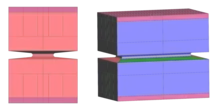

Concrete hinges are hinges produced out of concrete, with no or almost no steel in the hinge neck, which allows a rotation without a relevant bending moment.[1] This high rotations[2][3] are resulting from controlled tensile cracks as well as creep.[4][3][1] Concrete hinges are mostly used in bridge engineering[1] as monolithic, simple, economic alternative to steel hinges, which would need regular maintenance. Concrete hinges are also used in tunnel engineering.[1][3] A concrete hinge consist of the hinge neck, which has a reduced cross section and of the hinge heads, which have a strong reinforcement.[3][1][5]
History and guidelines
Freyssinet[6][7] invented the concrete hinges.[1][3] Leonhardt introduced guidelines in the 1960s which are still used till the 2010s.[1][3] Janßen introduced the application of concrete hinges in tunnel engineering.[8][3] Gladwell developed another guideline for narrowing cross sections, which predicts a stiffer behaviour than the Leonhardt/Janßen-model[3] Marx and Schacht translated Leonhardts guidelines for the first time in the nowadays used semipropablistic safteyconcept. Schlappal,[3] Kalliauer[1] and coworkers introduced for the first time both limit caces (service-limit-states (SLS) and ultimate-limite-states (ULS)). Kaufmann, Markić und Bimschas did further studies on concrete hinges.[9]
Stresses, rotational capacity, bearing capacity



Due to triaxial compression, strength in the neck region is much higher than for uniaxial compression,[4] because lateral expansion is restricted.[1] Eurocode 2 suggests for typical dimensions a compressive strength equal to about twice of the unixalial compressive strength.[1] Also the concrete hinge neck has no, or almost no reinforcement,[1] but the concrete hinge heads need a dense reinforcement cache, because of the tensile splitting.[10][9]
Literature
- Fritz Leonhardt: Vorlesungen über Massivbau - Teil 2 Sonderfälle der Bemessung im Stahlbetonbau. [Concrete hinges: test report, recommendations for structural design. Critical stress states of concrete under multiaxial static short-term loading Springer-Verlag, Berlin 1986, ISBN 3-540-16746-3, S. 123–132. (in German)
- VPI: Der Prüfingenieur. Ausgabe April 2010, S. 15–26, (bvpi.de PDF; 2,3 MB). (in German)
References
- 1 2 3 4 5 6 7 8 9 10 11 Johannes Kalliauer; Thomas Schlappal; Markus Vill; Herbert Mang; Bernhard Pichler (2018-02-01). "Bearing capacity of concrete hinges subjected to eccentric compression: multiscale structural analysis of experiments". Acta Mechanica. 229 (2): 849–866. doi:10.1007/s00707-017-2004-3. hdl:10044/1/57805. ISSN 1619-6937.
- ↑ Schlappal et al. did experiments till above 50mrad (Fig11).
- 1 2 3 4 5 6 7 8 9 Thomas Schlappal; Michael Schweigler; Susanne Gmainer; Martin Peyerl; Bernhard Pichler (2017), "Creep and cracking of concrete hinges: insight from centric and eccentric compression experiments", Materials and Structures, Springer, vol. 50, no. 6, p. 244, doi:10.1617/s11527-017-1112-9, PMC 5700241, PMID 29213209
- 1 2 Johannes Kalliauer; Thomas Schlappal; Herbert A. Mang; Bernhard Pichler (2018). "Parameter identification as the basis for Finite Element simulations of Ultimate Limit States of concrete hinges". In Günther Meschke; Bernhard Pichler; Jan G. Rots (eds.). Computational Modelling of Concrete Structures: Proceedings of the Conference on Computational Modelling of Concrete and Concrete Structures (EURO-C 2018), February 26 – March 1, 2018, Bad Hofgastein, Austria. CRC Press. p. 689. Retrieved 2018-03-06.
- ↑ Fritz Leonhardt; Horst Reimann (1965), Betongelenke: Versuchsbericht; Vorschläge zur Bemessung und konstruktiven Ausbildung. Kritische Spannungszustände des Betons bei mehrachsiger, ruhender Kurzzeitbelastung (in German), Ernst
- ↑ Eugène Freyssinet (1923), "Le pont de Candelier (The bridge of Candelier)", Ann Ponts Chaussées (in French), vol. 1, pp. 165f
- ↑ Eugène Freyssinet (1954), "Naissance du béton précontraint et vues d'avenir.", Travaux, Juni (in French), pp. 463–474
- ↑ Pieter Janßen (1983), Tragverhalten von Tunnelausbauten mit Gelenktübbings (in German), Dissertation, Technische Universität Braunschweig
- 1 2 Walter Kaufmann; Tomislav Markić; Martin Bimschas (February 2017), Betongelenke - Stand der Technik und Entwicklungspotential (PDF) (in German), Institut für Baustatik und Konstruktion, ETH Zürich
- ↑ Johannes Kalliauer (2016-04-29), Insight into the structural behavior of concrete hinges by means of Finite Element simulations, Wien: TU Wien - Vienna University of Technology